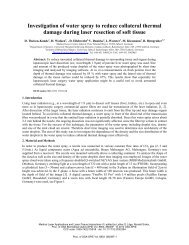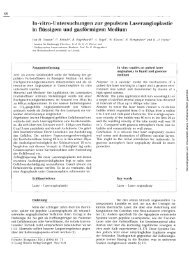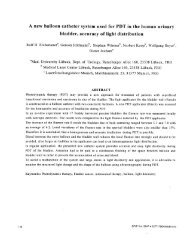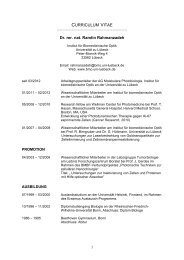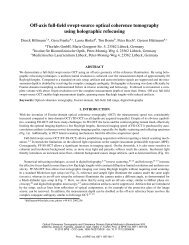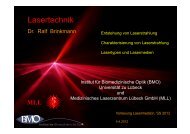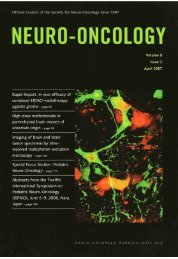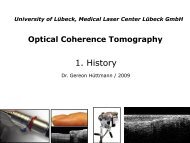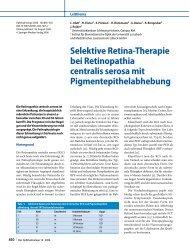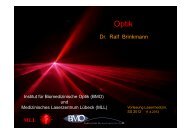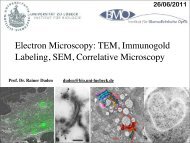Invited p aper Mechanisms of femtosecond laser nanosurgery of ...
Invited p aper Mechanisms of femtosecond laser nanosurgery of ...
Invited p aper Mechanisms of femtosecond laser nanosurgery of ...
You also want an ePaper? Increase the reach of your titles
YUMPU automatically turns print PDFs into web optimized ePapers that Google loves.
VOGEL et al. <strong>Mechanisms</strong> <strong>of</strong> <strong>femtosecond</strong> <strong>laser</strong> <strong>nanosurgery</strong> <strong>of</strong> cells and tissues 1023in a much smoother way (Fig. 3d) than for ns pulses (Fig. 3c).Therefore, one can generate any desired free-electron densityby selecting an appropriate irradiance value.Figure 4 presents threshold values for irradiance, I rate ,andradiant exposure, F rate = I rate × τ L , required to reach a criticalfree-electron density <strong>of</strong> ϱ cr = 10 21 cm −3 . The thresholds werecalculated for various wavelengths and pulse durations rangingfrom 10 fs to 10 ns. Two regimes can be distinguished: forτ L < 10 ps, the threshold radiant exposure F rate exhibits onlya weak dependence on pulse duration. This reflects the factthat recombination plays only a minor role during ultra-short<strong>laser</strong> pulses. Therefore, only one set <strong>of</strong> free electrons is producedthat corresponds to an approximately constant energydensity within the focal volume. This is in accordance with theexperimental threshold criterion <strong>of</strong> bubble formation that requiresa specific energy density, which varies little with <strong>laser</strong>parameters. By contrast, for longer pulses more than one set<strong>of</strong> free electrons is produced and they recombine during the<strong>laser</strong> pulse. Here it is the threshold irradiance I rate that remainsapproximately constant, because a minimum irradiance is requiredto provide the seed electrons for the ionization cascadeby multiphoton ionization and to drive the cascade sufficientlyfast to reach the critical free-electron density within the <strong>laser</strong>pulse duration. As a consequence <strong>of</strong> the constant threshold irradiance,the radiant exposure threshold and plasma energydensity increase steeply with increasing pulse duration.The predicted form <strong>of</strong> the F rate (τ L ) dependence qualitativelymatches experimental observations <strong>of</strong> the pulsedurationdependence <strong>of</strong> single-shot damage thresholds at surfaces<strong>of</strong> transparent large-band-gap dielectrics [112, 129] andablation thresholds <strong>of</strong> corneal tissue [13, 130]. However, studiesin which single-shot thresholds at longer pulse durationsare mixed with multiple-shot thresholds at ultra-short durationsshow a steeper F rate (τ L ) dependence for τ L < 10 ps bothin corneal tissue [131, 132] and dielectrics [116, 123]. Thelower thresholds with multiple exposures are due to accumulativeeffects, the possibility <strong>of</strong> which is explained by thesmooth ϱ max (I/I rate ) dependence shown in Fig. 3d.The predicted wavelength dependence in the picosecondand nanosecond regimes (increasing threshold with decreasingwavelength) seems to be a little surprising at first sight,because multiphoton processes occur more easily at shorterwavelengths. However, one needs to keep in mind that the cascadeionization rate increases approximately proportionally tothe square <strong>of</strong> the <strong>laser</strong> wavelength, as evident from (8).2.4 Low-density plasmas in bulk mediaFIGURE 4 Calculated optical breakdown thresholds (ϱ cr = 10 21 cm −3 )asa function <strong>of</strong> <strong>laser</strong> pulse duration for various <strong>laser</strong> wavelengths. (a) Irradiancethresholds, (b) radiant exposure thesholdsOur numerical calculations for <strong>femtosecond</strong> breakdownin bulk transparent media indicate that it is possible tocreate low-density plasmas in which the energy density remainsbelow the level that leads to cavity formation in themedium. Experimental evidence for the existence <strong>of</strong> lowdensityplasmas was recently provided by Mao et al. [18]through measurements <strong>of</strong> the free-electron density in MgOand SiO 2 . Free electrons are produced in a fairly large irradiancerange below the optical breakdown threshold, witha deterministic relationship between free-electron density andirradiance. Low-density plasmas thus <strong>of</strong>fer the possibility todeliberately produce chemical changes, heating, and thermomechanicaleffects by varying the irradiance. These effects arevery well localized because <strong>of</strong> the nonlinearity <strong>of</strong> the plasmaformationprocess, which, for sufficiently small irradiances,allows us to produce a plasma in a volume that is smaller thanthe diffraction-limited focus.For larger irradiances, plasmas in bulk media grow beyondthe region <strong>of</strong> the beam waist, which is not possible forplasma formation at surfaces [116, 120, 121]. At surfaces, theenergy deposition becomes confined to a thin layer <strong>of</strong> less than100-nm thickness once the free-electron density reaches thecritical density, because the superficial plasma layer is highlyabsorbing and reflecting [116, 121, 133–135]. By contrast, inbulk media there is no restriction for the region <strong>of</strong> opticalbreakdown to spread towards the incoming <strong>laser</strong> beam withincreasing irradiance. At large irradiances, breakdown startsto occur before the <strong>femtosecond</strong> pulse reaches the beam waist,and both irradiance and beam propagation are influenced bythe plasma generation [21, 136]. These effects shield the focalregion, enlarge the size <strong>of</strong> the breakdown region, and limitthe free-electron density and energy density reached in the entirebreakdown volume [21, 80, 137–139]. Low-density plasmascan, therefore, easily be produced in bulk media whileat surfaces the self-induced confinement <strong>of</strong> plasma formationto a thin layer leads to a rapid rise <strong>of</strong> free-electron densitywith irradiance, and the irradiance range in which low-densityplasmas can be formed is very small [116, 120].The desired chemical or physical effects <strong>of</strong> low-densityplasmas can be precisely selected if the slope <strong>of</strong> theϱ max (I/I rate ) curve is small because that <strong>of</strong>fers a large



